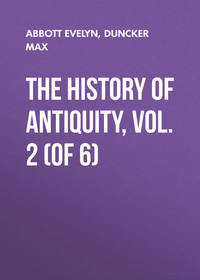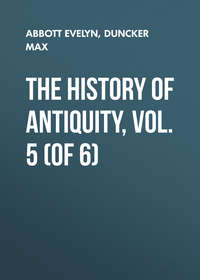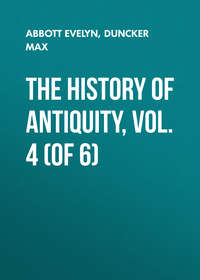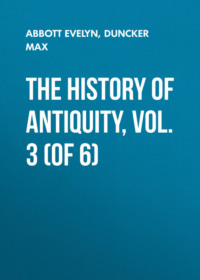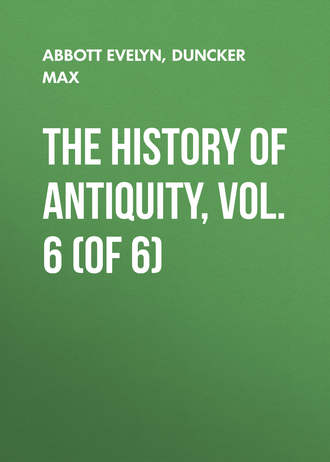 полная версия
полная версияThe History of Antiquity, Vol. 6 (of 6)
353
Herod. 5, 14; 8, 98; Xenoph. "Cyri Instit." 8, 6, 17. Suidas and Hesychius Ἀστάνδης, Ἄγγαρος. Plut. "Artax." 25; "Alex." 18. Xenophon ascribes even this arrangement to Cyrus, but it could only be made effectual by a network of first-rate roads.
354
Herod. 3, 128; Ezra i. 23; vi. 2; Esther iii. 9, 12-15; Arrian, "Anab." 3, 11.
355
In Layard; cf. Brandis, "Münzwesen in Vorderasien," s. 231.
356
Herod. 5, 35, 49-52. 7, 239.
357
Xenoph. "Cyri Instit." 8, 6, 16.
358
Xenoph. "Oecon." 4, 8-12.
359
Herod. 1, 114; Aesch. "Pers." 980; Plut. "Artax." 12. Suidas and Hesych. ὀφθαλμός; Xenoph. "Cyri Instit." 8, 6, 16; 8, 2, 11.
360
Xenoph. "Cyri Instit." 8, 2, 10; Brisson, "De Reg. Pers." 1, 190.
361
Herod. 5, 35, 49-52; 7, 239; Brisson, loc. cit. 1, 180.
362
Herod. 3, 129; 4, 166; Plut. "Artax." 23.
363
Above, p. 247, 248.
364
Herod. 4, 84; 7, 194.
365
Xenoph. "Anab." 1, 9; Brisson, "de Reg. Pers." 2, 227 ff.
366
Xenoph. "Anab." 1, 6; Plut. "Artax." 29; Curtius, 3, 2, 16-19; Diod. 17, 30.
367
Plut. "Artax." 14, 16, 17, 19; Xenoph. "Anab." 2, 6.
368
In his "Metrological Studies" Böckh fixed the ratio of the Euboean to the Babylonian talent as 5:6. Since that time the discovery of numerous gold and silver Persian coins and of weights at Babylon and Nineveh, and the lion of Abydus with its Aramaean stamp, have provided the means for fixing the gold talent of Darius at 25,245 kilogrammes, and his silver talent (the Babylonian talent) at 33,660 kilogrammes; Brandis, "Münzwesen," s. 54, 63, 64, 69. Hence Brandis takes Mommsen's view, that in Herod. 3, 89, 95, we must read 78 instead of 70 Euboean talents; the Euboean talent in Attica was a little heavier than the light Babylonian talent (the gold talent of Darius), and in the calculation 7600 Babylonian talents must be made equal to 9880 Euboean talents, which enables us to preserve the total sum given by Herodotus – 14,560 talents.
369
Brandis, "Münzwesen," s. 225, 231, 239, 241.
370
Herod. 3, 96; Strabo, p. 735.
371
Herod. 3, 89; Xenoph. "Hellen." 3, 4, 25.
372
Herod. 6, 42.
373
Herod. 1, 192; Böckh, "Staatshaush." 12, 130.
374
Herod. 3, 117; 2, 149.
375
Herod. 1, 192.
376
Strabo, p. 525.
377
Xenoph. "Anab." 4, 5, 34 ff.
378
Herod. 3, 91; Böckh, "Staatshaush." 12, 135.
379
Xenoph. "Cyri Inst." 8, 6, 23; Athenaeus, p. 145, 146.
380
Strabo, p. 735.
381
In Athenaeus, p. 145.
382
Loc. cit. in Athenaeus.
383
Herod. 7, 118; Plut. "Artax." c. 4, 5.
384
In Athenaeus, p. 146.
385
Herod. 1, 192.
386
Herod. 9, 109; Xenoph. "Anab." 1, 4, 9; 2, 4, 27; Plato, "Alcib. I." p. 123; Cic. "In Verrem," 3, 33.
387
Xenoph. "Cyri Inst." 8, 6, 5.
388
Xenoph. "Hellen." 3, 1, 6; "Anab." 2, 1, 3; 7, 8, 8; Thucyd. 1, 138; Plutarch, "Themist." 29 ff. That Themistocles was prince of Magnesia is the less doubtful because a silver stater of this city, 8,56 grammes in weight, with the square, and the name of Themistocles, is in existence: Mommsen. "Rom. Münzwesen," s. 65; Brandis, "Münzwesen in Vorderasien," s. 459, proves a second coin of Themistocles, 5.85 grammes in weight.
389
Droysen, "Hellenismus," 2, 44; Diod. 17, 52; Strabo, p. 798.
390
Nöldeke, "Tabari," s. 364 ff.
391
"Oecon." 4, 11, ff.
392
Xenoph. "Hellen." 4, 1, 33.
393
Plut. "Alcib." 24.
394
"Oecon." 4, 20-24; Aelian, "Hist. Anim." 1, 59.
395
Herod. 4, 39.
396
Herod. 4, 41.
397
Herod. 2, 158.
398
Herod. 4, 44. On the monuments of Darius, see Lepsius, "Chronol." s. 354, and "Monatsberichte B. A." 1866, s. 288; Oppert, "Mémoires prs. à l'Acad. des Inscrip." 1, 8 (1869), p. 646 ff. In opposition to the definite and detailed assertion of Herodotus, given in the text, the assertion in Strabo (p. 804) and Diodorus (1, 33) that Darius nearly finished the canal but did not quite finish it, cannot be accepted. Herodotus was in Egypt not much more than 30 years after the death of Darius (about 450 B.C.). Diodorus and Strabo accept the tradition of the times of the Ptolemies, which sought to claim for them the glory of completing the work, though they did no more than reopen the canal which had become silted up. To support this tradition Oppert has supplemented the decisive word of which no more than the syllable ta remains, according to his transcription, in such a way that the meaning extracted is that Darius filled up his own canal. I do not see why this ta should not be a part of uçtaka, i. e. to excavate, as well as of vikata, i. e. to make level. We cannot assume without further evidence that Darius set up a monument over the failure of his undertaking or its destruction. The Turanian version, which Oppert has since published ("Peuple des Mèdes," p. 214) does not help us to a decision, for it is only preserved as far as the place in question.
399
Xenoph. "Cyri Inst." 7, 5, 66.
400
Xenoph. "Cyri Inst." 8, 8, 20-22.
401
Herod. 3, 127; 5, 102; Xenoph. "Anab." 1, 2; Diod. 11, 34; Arrian, "Anab." 1, 29.
402
Herod. 2, 30.
403
Xenoph. "Oecon." 4, 5.
404
Xenoph. "Cyri Inst." 6, 2, 11.
405
"Oecon." 4, 5.
406
Herod. 7, 40, 41, 83; 8, 113; Heraclid. Cuman. fragm. 1, ed. Müller; Xenoph. "Cyri Inst." 7, 5, 68.
407
Curtius, 3, 3, 13; Xenoph. loc. cit.
408
It is true that the population between the Euphrates and the Indus is now rated at 18,000,000 only. Kenneir, "Geograph. Memoir of Persia," p. 44-47. But the numbers of the prisoners and the slain in the inscriptions of Behistun allow us to conclude that the population of Iran was far greater. Under the Ptolemies Egypt, consisting of about 30,000 communities, counted 7,000,000 inhabitants; Diod. 1, 31. That Asia Minor was not less populous is proved, for certain districts, by the statements of Xenophon; the budget of Darius, the numbers of his army, and more especially of the army of Xerxes, the mass of troops which the younger Cyrus collects in Asia Minor and Artaxerxes in the Eastern provinces, are evidence of a tolerably dense population.
409
"Pers.," 239, 926.
410
Herod. 7, 61.
411
Herod. 7, 85; 8, 113; Xenoph. "Anab." 1, 8, 7; "Cyri Inst." 8, 8, 22; Arrian, "Anab." 3, 13.
412
Herod. 5, 49; 9, 62; Strabo, p. 734.
413
Herod. 9, 20, 22, 63, 80; Plut. "Artax." 9; Aeschyl. "Pers." 26-28.
414
Herod. 1, 134; Polyaen. "Strat." 7, 11. According to Herodotus the Sacae were in the centre at Marathon. Mardonius retains them in Thessaly with the Bactrians and Indians: Herod. 8, 113; 9, 31. In the battle at Arbela they were among the bravest: Arrian, "Anab." 3, 13.
415
Herod. 7, 64 ff.
416
Herod. 7, 82, 83; Xenoph. "Cyri Inst." 8, 1, 14.
417
Herod. 7, 81.
418
Herod. 7, 96.
419
Herod. 7, 100; Xenoph. "Cyri Inst." 8, 5, 1-16.
420
Herod. 9, 15.
421
Xenoph. "Anab." 3, 4, 35.
422
Curtius, 3, 3, 8.
423
Brisson, loc. cit. 3, c. 89.
424
Curtius, 3, 3, 14, 15; Xenoph. "Anab." 1, 9, 31.
425
Xenoph. "Anab." 1, 8; Arrian, "Anab." 3, 11.
426
Artaxerxes is on horseback in the battle of Cunaxa; Plutarch, "Artax." 10, 11, but the general custom is given in c. 6.
427
Xenoph. "Anab." 1, 10, 12. Vol. V. 172.
428
Xenoph. "Anab." 1, 8.
429
Herod. 7, 218, 226; Xenoph. "Cyri Inst." 8, 8, 22, 23.
430
Herod. 9, 20, 23, 49.
431
Above, p. 303. Herod. 1, 162, 168; 4, 200; 5, 115; Polyaen. "Strateg." 7, 2, 5.
432
The name in Hebrew is Shushan, among the Assyrians, Shusan, hodie, Shush.
433
Loftus, "Travels in Susiana," p. 425 ff. Nöldeke ("Göttingen G. G." 1874, s. 173 ff.) has treated exhaustively of the various names of ancient Elam, as Susiana is invariably called among the Assyrians, Babylonians, and Hebrews. He proves that the name Κισσίη which is in use among the older Greeks, Aeschylus, Hecataeus, and Herodotus, must be derived from the Kossaeans, a tribe who inhabited the northern and higher part of Susiana, and the mountainous edge towards Iran. Of later writers Polybius only uses the name Cissians, who also uses the name Matieni in the sense of Herodotus. Uwaya, the name common among the Persians for Susiana, is taken from the Uxians, who were the eastern neighbours of Persia, i. e. the tribe in Susiana which dwelt nearest to Persia; it is retained in the new Persian Chuz and Chusistan. Among the Greeks the name Elymaeans is first used by the companions of Alexander as the name for a tribe, and then in the second century B.C. as the name of a new kingdom which restored the ancient Elam. Yet to this tribe which inhabited the plain and the hills of Susa and Shuster was due the foundation and government of the kingdom which once ruled in the valley of the Euphrates, which so long resisted the Assyrians, but was entirely unknown to the Greeks. The rivers of Susiana are difficult to fix, as both Persian and native names are indifferently used. The name Choaspes, which contains açpa, is plainly Persian; it is no doubt the Kerkha. On the Eulaeus, Koprates, and Pasitigris, see Droysen, "Hellenismus," 12, 266 n.
434
Aesch. "Pers." 16, 120; Athen. p. 513; Strabo, p. 728, 731, 739; Diod. 17, 65.
435
Polyb. 5, 48.
436
Plin. "Hist. Nat." 6, 31; Daniel viii. 2, 16.
437
"Pers." 3, 4, 159, 160.
438
Ael. "Hist. An." 1, 59.
439
Ménant, "Achaemenides," p. 140, 141; Oppert, "Peuple des Mèdes," p. 229.
440
Curtius, 5, 4.
441
Diod. 17, 71.
442
Oppert, "Peuple des Mèdes," 196.
443
Oppert, loc. cit. 19, 148; Spiegel, "Keilinschriften," s. 49; Schrader, "Assyr. Babyl. Keilinschriften," s. 363.
444
Texier, "Description," pl. 100.
445
Impressions of seals which have been discovered in the palace of Sennacherib at Kuyundshik, represent the king of Assyria in precisely the same position. – Layard, "Nineveh and Babylon," p. 154, 161.
446
Esther i. 6, 7.
447
Inscriptions H. and J. Oppert, "Journal Asiatique," 19, 141; Spiegel, "Keilinschriften," s. 49. Oppert now translates aniya not by "enemy" but literally by "the other;" by which Angromainyu would be meant: "Peuple des Mèdes," p. 199.
448
Viçadahyaus; Spiegel, loc. cit. s. 57; Benfey, "Keilinschriften," s. 63-65; Schrader, loc. cit. s. 364.
449
Above, p. 272 n.
450
Oppert. "Z. D. M. G." 11, 133 ff.; Mordtmann, loc. cit. 16, 109 ff.; Spiegel, "Keilinschriften," s. 52; Schrader, loc. cit. s. 361.
451
Above, p. 272 n., 307.
452
So the Babylonian text.
453
It is merely a guess that saraçtibara means bow-bearer; Spiegel, "Keilinschriften," s. 106. Oppert translates: bearer of the commands of the king; "Peuple des Mèdes," p. 213.
454
Strabo, p. 728, 735.
455
"Anab." 3, 5, 15.
456
Nöldeke, "Tabari," s. 353. Xenophon's statements about the residences in the "Anabasis" (loc. cit.) cannot be outweighed by the systematized arrangement in the "Cyropaedia" that Cyrus spent three months at Susa, two at Ecbatana, and seven months at Babylon, which Plutarch ("De Exilio," c. 12) repeats in the form, that the Persian kings passed the spring at Susa, the summer in Media, and the winter in Babylon. With Aeschylus and Herodotus Susa is a fixed residence, and so also in the treatise "De Mundo," p. 398, and the Hebrews, e. g. Nehemiah i. 1. Joseph. "Antiq." 10, 11, 7. Athenaeus, p. 513, thinks that Persepolis was the residence for the autumn. In the winter of the year 396-395 Conon finds Artaxerxes II. at Babylon; the same king says in Plutarch ("Artax." c. 19) to Parysatis, that he will never see Babylon as long as she lives.
457
Plut. "Artax." c. 5.
458
Diod. 17, 77.
459
Aeschyl. "Pers." 660.
460
Plut. "Artax." c. 26.
461
Diod. 17, 77; Xenoph. "Cyri Inst." 8, 3, 13.
462
Plutarch ("Artax." c. 24) maintains, it is true, that this is the value of the garments which the king habitually wore. Arrian treats of this subject, "Anab." 4, 7, and Curtius, 3, 3, 17-19; 6, 6, 4. With respect to the royal colours, cf. Esther i. 6.
463
Phan. Eres. Fragm. 9, ed. Müller; Plut. "Artax." c. 20, 23; Strabo, p. 525.
464
Esther iv. 11. Cf. Herod. 3, 118, 119.
465
Heracl. Cum. fragm. 1, ed. Müller; Esther v. 4.
466
Herod. 1, 134; Strabo, p. 734.
467
Arrian, "Anab." 4, 11.
468
Xenoph. "Hellen." 2, 1; 8.
469
Herod. 7, 54; Xenoph. "Cyri Inst." 8, 1, 23, 24, with the addition that this was the custom in his day. Plut. "Ad princ. ineruditum," 3.
470
Plutarch, "Artax." c. 5; "Conjug. praecepta," c. 16; "Quaest. Conviv." 1, 3, 1.
471
Heracl. Cum. fragm. 2; Xenoph. "Hellen." 4, 1, 30.
472
"Cyri Inst." 8, 4, 2, 3.
473
Suidas, Ἐδέατρος.
474
"Cyri Inst." 5, 2, 17.
475
Plut. "Quaest. Conviv." 7, 4, 5.
476
Athenaeus, p. 145. Above, p. 352.
477
Plut. "Quaest. Conviv." 1, 1, 1; "Conjug. praecepta," 16.
478
Heracl. Cum. fragm. 2; Diod. 17, 77.
479
Ctesias and Darius, in Athenaeus, p. 434.
480
Herod. 9, 110, 111; Esther ii. 18.
481
"Alcib. I." p. 121.
482
Heracl. Cum. fragm. 1, ed. Müller.
483
Xenoph. "Anab." 4, 4, 4.
484
Herod. 7, 54; Curtius, 5, 1, 20.
485
Herod. 7, 40, 41; 54, 55; Xenoph. "Cyri Inst." 8, 3, 5-10; Curtius, 3, 3, 21.
486
Herod. 7, 2, 97; 8, 89. Herodotus (7, 68) calls Arsamenes the son of Darius, and (7, 69) Arsames the son of Darius and Artystone. Artabazanes is called by Justin (2, 10) Artamenes.
487
Herod. 7, 224; Justin, 2, 10.
488
Diod. 17, 77; Athenaeus, p. 557.
489
Esther ii. 7-17; v. 2; viii. 4.
490
Deinon in Athenaeus, p. 557.
491
Heracl. Cum. fragm. 1, ed. Müller; Plut. "Artax." c. 27.
492
Plut. "Artax." 5.
493
Xenoph. "Cyri Inst." 7, 5, 58.
494
Xenoph. "Cyri Inst." 8, 1, 9; 8, 8, 20; Plut. "Artax." c. 19; Nicol. Damasc. fragm. 66, ed. Müller. On the physicians, above, p. 134, 313.
495
Herod. (1, 188) ascribes this custom to Cyrus, though the reference to Susa which he adds shows that it can only have come into existence after Susa became a residence.
496
Demosth. "Symmor." p. 185.
497
Athenaeus, p. 608.
498
Plut. "Artax." c. 13; Xenoph. "Cyri Inst." 8, 1, 40; "Anab." 1, 5, 8; Strabo, p. 734.
499
Xenoph. "Cyri Inst." 8, 8, 17.
500
Aeschyl. "Pers." 543; Xenophon, "Cyri Inst." 8, 8, 16.
501
Herod. 1, 133; Heracleides of Cyme (Fragm. 2, ed. Müller) contests the excess of the king at table as well as of the officers and generals. Cf. Xenoph. "Cyri Inst." 5, 2, 17; 8, 8, 10; Strabo, p. 733, 734.
502
Herod. 1, 135.
503
Herod. 7, 83, 187; 9, 76, 80, 81, 82; Xenoph. "Anab." 4, 4.
504
Xenoph. "Cyri Inst." 8, 8, 8 ff.
505
Xenoph. "Cyri Inst." 8, 8, 15; Heracl. Pont. ap. Athenaeum, p. 512.
506
Plut. "Artax." 24, 25; Xenoph. "Anab." 1, 5; "Cyri Inst." 8, 8, 2; Thuc. 2, 17.
507
Diod. 17, 114. Cf. Curtius, 3, 3, 9.
508
Plut. "Artax." 3.
509
Vol. V. 32, 37. "Aban Yasht," 22, 25, 46, 50.




